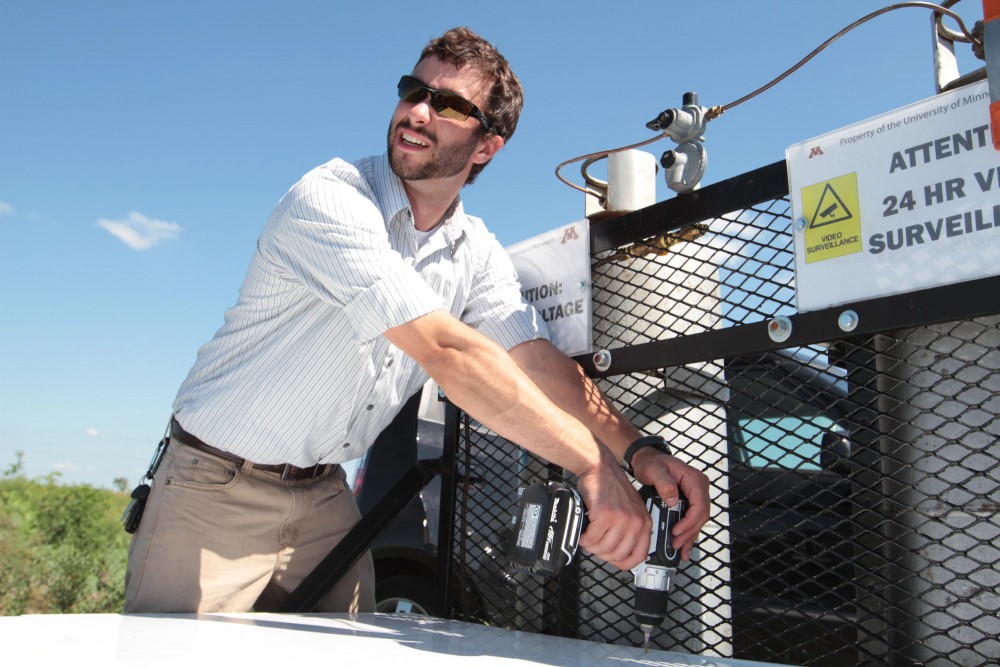A Department of Energy official dropped by Morrill Hall to visit University of Minnesota President Eric Kaler, bringing with him the news that Congress will likely cut funding for energy research programs that have fueled University research projects for years.
Under Secretary for Science Steven KooninâÄôs discussion with Kaler and Vice President for Research Tim Mulcahy ranged from Gophers football to the new presidentâÄôs job, plus a grim glimpse into the energy departmentâÄôs fiscal future.
Between 2005 and 2010, the DOE awarded the University of Minnesota more than $100 million for 220 proposals, according to the Office of the Vice President for Research.
But with constrictions in the new federal budget expected to shave money from the energy departmentâÄôs applied energy research budget of $4 billion and stimulus grants running out, the departmentâÄôs funding foundation for University research is looking shaky as well.
Researchers and administrative officials will look to partnerships with private companies to compensate for less federal funding opportunities, said civil engineering professor Fotis Sotiropoulos, a DOE grant recipient.
The private meeting was intended to get KooninâÄôs perspective on the DOEâÄôs funding future, Mulcahy said. Like every other federal department, âÄútheyâÄôre struggling with budget,âÄù Mulcahy said.
The DOEâÄôs largest budget categories âÄî nuclear stockpiling and basic science research âÄî have broad bipartisan support in Congress, meaning that if all goes well, their funding might remain flat.
Research in biofuels, solar energy, wind energy and carbon footprint reduction âÄî all areas of applied energy, which has taken on a politically sensitive hue since President Barack Obama made American energy independence a national priority âÄî is at higher risk of losing funding, Koonin said in an interview.
The end result, Koonin said, may be less money from Congress to fund those kinds of alternative energy areas.
About half of the $100 million in DOE funds awarded to the University since 2005 were stimulus funds, part of ObamaâÄôs American Recovery and Reinvestment Act.
Several large, two-year stimulus grants amounting to at least $12 million went to applied energy research on biofuels and wind energy at the University in 2009 and 2010, said John Merritt, a spokesman for the UniversityâÄôs office for research.
Those grants will run out this year if they havenâÄôt already, Merritt said.
In their meeting with Koonin, Mulcahy said he and Kaler expressed disappointment that the energy departmentâÄôs appropriations from Congress for applied energy research âÄúdidnâÄôt reflect the urgencyâÄù the two felt the area deserved.
The University administration counts energy innovation as one of its research strengths. In 2009, it was one of three schools to win $8 million from the DOE to participate in wind turbine research.
That money will soon dry up, but Sotiropoulos, the principal investigator of the project, said that being one of few locations nationally to have a wind turbine positions the school to receive more applied energy funding in the future.
âÄúItâÄôs a tough funding environment, but IâÄôd rather be in this climate with this facility than without,âÄù he said.
Kaler visited UMore Park, the Rosemount, Minn., site where the wind turbine is being built, on Friday. From 2000 to 2007, Kaler served as dean of the University of DelawareâÄôs College of Engineering.
In addition to support from the government and the University, the wind turbine project benefits from local companies that are willing to sponsor them in exchange for the results of their research. The original consortium included companies Lockheed Martin, 3M and Honeywell, but Sotiropoulos said that expanding industry partnerships further will be important for financial sustainability.
Koonin echoed the sentiment in his interview with the Minnesota Daily. Government alone does not have the resources to operate the nationâÄôs energy system and so it must catalyze the private sector, he said.
âÄúThe only way you impact energy is through the private sector,âÄù he said.
One research purpose of the UniversityâÄôs wind turbine, once itâÄôs completed, will be to test whether an experimental technology called the 3M riblet film can be useful for reducing drag in turbines as it has done in aircraft and sailboats.
Researchers believe the technology may also reduce ice accumulation âÄî a particular concern in Minnesota, Sotiropoulos said. The turbine will be equipped with sensors on its blades and base to gather data that could ultimately lead to an entirely new market for the 3M riblet.
Although the direction of applied energy research appears to be drifting toward external funding, Mulcahy said the University will continue to prioritize this wind energy research.
âÄúWe think we have major contributions to make in energy âÄî we arenâÄôt going to abandon that as a campus,âÄù Mulcahy said. âÄúWeâÄôre doing our best to compete for our piece of a smaller and smaller pie.âÄù


